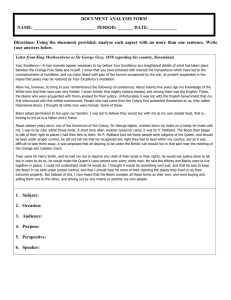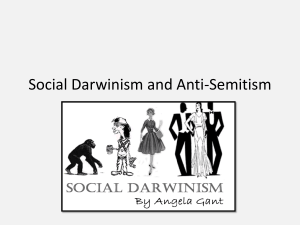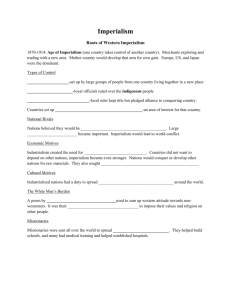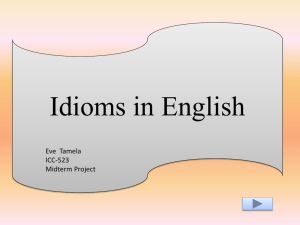Optimising a Lexical Approach to Instructed Second Language
advertisement
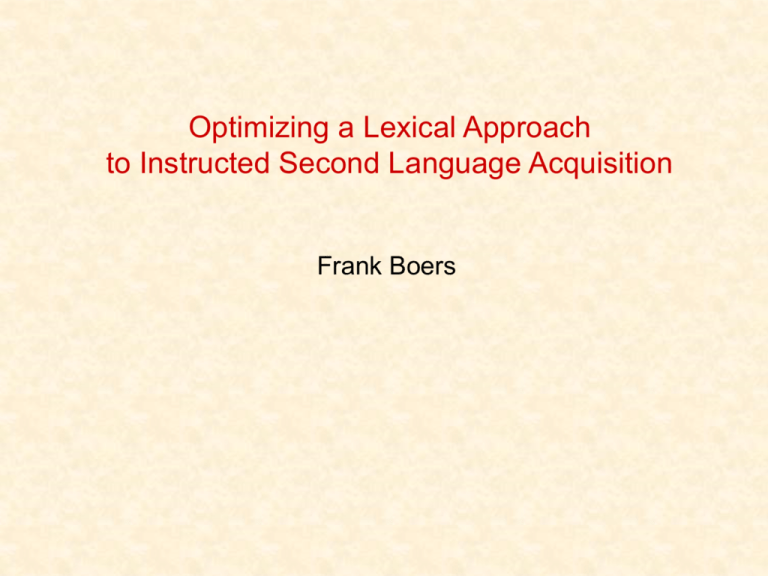
Optimizing a Lexical Approach to Instructed Second Language Acquisition Frank Boers What parts of language is this about? ‘Chunks’ (a.k.a. ‘phrases’, ‘formulaic sequences’, etc.) Fair trade coffee may be a familiar sight on supermarket shelves, but a new study has found the British do not practise what they preach when it comes to buying it. While most people claim to take social issues into consideration, their purchasing behaviour shows little evidence of this. Although the vast majority of consumers believe their choice could make a difference to companies' ethical policies, they are still failing to act on their beliefs. Fair trade coffee may be a familiar sight on supermarket shelves, but a new study has found the British do not practise what they preach / when it comes to buying it. While most people claim to take social issues into consideration, their purchasing behaviour shows little evidence of this. Although the vast majority of consumers believe their choice could make a difference to companies' ethical policies, they are still failing to act on their beliefs. More “chunking” practice Are the numbers of boys and girls in our families really down to the toss of a coin? In fact, it’s not quite so simple. You as an individual may actually load the dice towards a son or a daughter right at conception. Especially the condition of mothers could be playing a part according to some studies. Ruth Mace was in Ethiopia when that country was hit by a severe food shortage. As part of a study on nutrition she looked at the birth statistics of women caught up in the crisis: “Mothers that had a higher body-mass index were more likely to have boys than girls.” Why this happens is still open to debate. Valerie Grant says dominance in personality may also tip the balance towards male offspring: “I’ve come to notice that dominant women tend to have more boys.” Are the numbers of boys and girls in our families really down to the toss of a coin? In fact, it’s not quite so simple. You as an individual may actually load the dice towards a son or a daughter right at conception. Especially the condition of mothers could be playing a part according to some studies. Ruth Mace was in Ethiopia when that country was hit by a severe food shortage. As part of a study on nutrition she looked at the birth statistics of women caught up in the crisis: “Mothers that had a higher body-mass index were more likely to have boys than girls.” Why this happens is still open to debate. Valerie Grant says dominance in personality may also tip the balance towards male offspring: “I’ve come to notice that dominant women tend to have more boys.” Plenty and varied collocations (e.g. commit a crime), social-routine formulae (e.g. Have a nice day), discourse markers (e.g. On the other hand), compounds (e.g. peer pressure), idioms (e.g. take a backseat), standardised similes (e.g. clear as crystal), proverbs (e.g. When the cat’s away …), genre-typical clichés (e.g. Publish or perish), exclamations (e.g. You must be kidding!) open-slot frames (e.g. it takes [time][for x] to …) ... Principal function of chunks in L1 Receptive and productive fluency As a matter of ___ On the other __ Through thick and __ Last but not __ It was two in the morning and I was still wide __ The difference was not statistically __ Cf. genre analyses by K. Kuiper Cf. eyetracking studies by N. Schmitt & colleagues Cf. work by J. Bybee Principal functions of chunks in L2 • Fluency • Idiomaticity and Accuracy Avoidance of L1 interference: ? Do an effort ? With other words ? Realise a survey ? Let’s drink a glass ? Whose feet are you playing with? Any evidence ? Research procedure: • Speaking task in L2 • Oral proficiency scores by blind judges • Chunk-counts by more blind judges • Calculating correlations: proficiency scores ~ chunk counts? • Results: coefficients up to .60 (highly significant) • Conclusion: chunks are good for you ! Proposals for a chunk-oriented pedagogy • Nattinger and DeCarrico (1992). • Michael Lewis’ (1993, 1997, 2000) Lexical Approach. Not really ‘new’: e.g. Firth (1957): “You shall know a word by the company it keeps” Can you guess which verbs the following columns of nouns are strong collocates of? verb+ damage trouble pain cancer injury harm verb+ crime offence murder adultery rape fraud verb+ study research survey interview investigation experiment verb+ task function music dance song role Just a couple of challenges for the learner ... • About 50% of native-speaker discourse is estimated to be chunky (cf. Erman and Warren 2000) • The native speaker’s repertoire contains thousands of chunks (cf. Pawley and Syder 1983) Lewis’ Lexical Approach in a nutshell • The aim = learner autonomy: equip students with strategies to pick up L2 chunks outside the classroom. • Class time is best spent on awareness-raising; not by focussing on individual items. The key activity is chunking of texts. • Lexis is arbitrary teachers must not waste precious time on trying to give ‘explanations’ about chunks. “Why” questions should be answered by “That’s-just-theway-it is” answers. Does that work, then ? Learner autonomy? Set-up: – Experimental group: a school year of text chunking – Control group: same texts, but no chunking Post-test: both groups underline ‘chunks’ in a new text. Results: Experimental students underlined significantly more bits of text ... But not more chunks ... Catch 22: how can you recognise a chunk if you haven’t encountered it several times before? Likelihood of incidental acquisition? Incidental uptake of vocabulary is very slow. Why? - Requires multiple encounters (cf. Paul Nation) - Insufficient ‘noticing’ Any more hopeful when it comes to chunks? - Is a given chunk likely to be frequent enough? - Are chunks (e.g. make an effort) likely to attract attention? Verb-noun collocations in 120 pages of a popular novel Verb-noun collocations occurring more than once: make a point (p. 10; 61; 90); make a move (p. 26; 32; 78); make sense (p. 47; 73; 107); make a decision (p. 39; 50); spend time (p. 71; 88); pay attention (p. 91; 119); tell the truth (p. 28; 119). Verb-noun collocations occurring only once: complete a mission (p. 3); fulfil a task (p. 3); bend the truth (p. 6); spend the night (p. 15); lose your mind (p. 18); see the point (p. 21); clear your throat (p. 22); speak your mind (p. 23); make conversation (p. 26); do your duty (p. 28); shake hands (p. 32); practise a religion (p. 41); commit suicide (p. 44); waste time (p. 48); climb stairs (p. 52); pay a price (p. 54); take notice (p. 59); having a laugh (p. 63); do the right thing (p. 63); read your mind (p. 75); make a start (p. 82); give pause (p. 85); make an impression (p. 90); do your best (p. 92); shed light (p. 94); serve a purpose (p. 94); make a statement (p. 100); make no difference (p. 101); pay tribute (p. 102); spend the evening (p. 103); watch TV (p. 105); have a drink (p. 107); crack a joke (p. 112); take a look (p. 119); take a picture (p. 119). Eye-tracking Eye-tracking experiment • Procedure: comparison of reading behaviour real words versus pseudowords e.g. [...] push boundaries [...] versus [...] push paniplines [...] • Results: longer contemplation of pseudowords But: NO evidence of any attention to immediately preceding or succeeding words (i.e. potential collocates) But surely chunks attended to in class stand a good chance of retention ? Hmm... • Treatment: - experimental groups: a school year of text chunking - control groups: same texts, no chunking • Post-tests: speaking tasks; chunk-counts by blind judges • Results: NO differential uptake from the course materials! (in fact, very limited uptake altogether) Now what ? Let teachers do what they are good at: teach! • Do something with the chunks encountered in class • Help students remember through ‘elaboration’ Pathways for elaboration? First port of call: exploiting imagery Example What domain of experience do you think the following idiom comes from? “to show someone the ropes” • • • Prison/torture Boats/sailing Games/sports Feedback: a novice sailor needs to be taught by a experienced sailor which ropes he should handle What domain of experience do you think the following idiom comes from? “to cut no ice with someone” • Boats/sailing • Games/sports • Food/cooking Feedback: Ice skating: if the blades of your skates are too blunt, they will not cut into the ice, and so … What domain of experience do you think the following idiom comes from? “to jump the gun” • • • Jurisdiction / punishment Games / sports War / aggression Feedback: Athletics: a contender who jumps the gun sets off before the starting pistol has been fired. What domain of experience do you think the following idiom comes from? “to run the gauntlet” • • • food / cooking games / sports jurisdiction / punishment Feedback: Running the gauntlet used to be a form of punishment in the military in which the wrongdoer was forced to run between two lines of men armed with sticks, who beat him as he passed. Next stage What is the figurative meaning of the following idiom: “to show someone the ropes” • • • To disclose the truth to someone To give someone a severe penalty To teach someone how to do a task Next stage What is the figurative meaning of the following idiom: “to cut no ice with someone” • • • To have a misunderstanding To get on well with someone To make no impression on someone Next stage What is the figurative meaning of the following idiom: “to jump the gun” • • • Defend someone at your own peril Do something before the appropriate time Be startled by an unexpected event Next stage What is the figurative meaning of the following idiom “to run the gauntlet” • • • Run away from your hometown Be in a position of power Go through an unpleasant treatment consolidation When I started working here as a novice, nobody bothered to teach me how things were done around here. I had to find out all by myself how to do my new work properly. You could say that nobody showed me the _____________ consolidation Scientists argue that high voltage power lines increase the risk of cancer, but their arguments cut no ____________ with the big bosses of the electricity industry. The scientific evidence does not seem to make any impression on them. consolidation Although we had agreed not to tell anyone about my pregnancy until we were absolutely certain about it, my husband jumped the ___________ and told his parents straightaway. consolidation When her fellow-students found out she had started a relationship with one of their lecturers, she had to put up with a lot of verbal abuse. Her fellow-students really made her run the _______________. Summing up the procedure • Stage one: awareness of the origin of the idiom Purpose: dual coding (association with images) • Stage two: figuring out the meaning of the idiom Purpose: deep processing (from image to meaning) • Stage three: consolidation • Stage four to stage n: revision Synopsis of experiments Does it help? Control group: 1) Meaning MC 2) Gap fill Experimental group: 1) Origin MC 2) Gap fill Exp > Ctr p < .001 Across the idiom board? Yes, but below-average scores in case of: • Explanations longer than five lines • ‘Culture-specific’ source domains (e.g. cricket) Which sequence helps most? Control: 1) Meaning MC 2) Origin MC 3) Gap fill 72% Experimental: 1) Origin MC 2) Meaning MC 3) Gap fill 81% p < .01 Long-term effect? Gap-fill scores after two-year lapse mean 85% followed by origin MC gap-fill scores ~ origins scores: rs .8 A bit of a dampener on our enthusiasm: Troublesome standard deviations Cognitive-style variables ? Correlation analyses ‘Imager’ cognitive style ~ Gap-fill scores ? high imagers: mean 78% low imagers: mean 72% p < .05 So what? Let’s fix this … What domain of experience do you think the following idiom comes from? “a carrot-and-stick method” • • • Religion/superstition Animals/wildlife Food/cooking Feedback: Donkeys can be urged on by dangling a carrot before them and at the same time by hitting them with a stick. What domain of experience do you think the following idiom comes from? “to be at the end of one’s tether” • • • Prison/torture Animals/wildlife Games/sports Feedback: A tether is a rope that is used to restrict the movement of grazing cattle. One end is fastened around the animal's neck and the other to a stake. no more correlation with cognitive style high imagers: mean 70% low imagers: mean 73% Hooray for pictures ? Performance new cohort vs previous cohort ? Meaning MC: without pictures: with pictures: … Gap-fills: without pictures: with pictures: mean 77% mean 81% mean 75% mean 71.5% looking good hmm… Semantic elaboration # structural elaboration Contemplating a picture # Contemplating precise lexical composition (“form”) What domain of experience do you think the following idiom comes from? “to go for the jugular” • • • Entertainment/public performance Animals/wildlife Food/cooking The jugular is a vital vein in your neck. Predators (e.g. lions and tigers) tend to kill their prey by biting into this jugular. Picture-superiority effect? Does the picture distract? Within-subjects experiment • Matched pairs of idioms, targeting unfamiliar content words (e.g. trumps, tether, gauntlet, roughshod) • Half presented with a picture • Results: recollection in gapfill better after presentation without pictorials (p .03) • After presentation with pictorials: recollection of the concept, but not the word (violin instead of fiddle; rope instead of rein; throw instead of toss in the middle instead of halfway, etc.) Any pathways for structural elaboration ? Motivation for lexical composition ? • Why steer clear of rather than “sail clear of” ? • Why cut and run rather than “cut and sail away” ? • Why left high and dry rather than “left up and dry” ? phonological motivation ? e.g. rhyme: brain drain; fair and square; a fat cat; horses for courses; an eager beaver; drunk as a skunk; when the cat’s away … Scope of rhyme ? Only about 2% of the English idiom repertoire … Hmm... How about other phonological repetition ? For example: why … Time will tell rather than “Time will show” ? It takes two to tango rather than “It takes two to waltz” ? Alliteration Scope of alliteration ? About 17% of the English idiom repertoire “Coverage” by alliteration + rhyme ? 19% of English idioms overall 23% of ‘frequent’ English idioms 28% of binomials (chop and change; part and parcel) 41% of similes (cool as a cucumber; fit as a fiddle) Alliteration across phraseology Compounds: baby boom; baby buggy; baby blues; ballot box; bargain basement Collocations: tell a tale; wage war; commit a crime; make a mess vs. do damage Proverbs: curiosity killed the … ; where there’s a will …; he who pays the …; that’s the way the cookie … Discourse markers: first and foremost; It is safe to say that Exclamations: Good God! Trick or treat! Miscellaneous: by common consent; a sight for sore eyes; publish or perish ‘Statistical’ evidence ? On-line collocations sampler data Inviting strong collocates: • Seek + sanctuary; settlement; solution, solace, solitude, support; asylym; advice. Look for + /s/-nouns ? Only 1 (solution). • Fulfil + function, fantasy, prophesy, life. Satisfy + /f/-nouns ? None. Good old Google Fundamentally flawed: Fatally flawed: Badly flawed: Basically flawed: Mortally flawed: 1,130,000 hits 851,000 hits 143,000 hits 23,100 hits 550 hits Multiword dictionary entries Beach bums, beer bellies and the big bang B_ D_ B_ D_ + B_ 15% 9% +D 4% 10% + other 85% 91% + other 86% 90% p < .001 p < .001 More multiword dictionary entries Peer pressure on penny-pinching party poopers P_ T_ P_ T_ + P_ 14% 8% + T_ 5% 10% + other 86% 92% + other 95% 90% p < .001 p < .001 Many more multiword dictionary entries force-feeding French fries and fish fingers to fullyfledged flip-flops: far-fetched fact-finding? F_ M_ + F_ 11% 2% + other 91% 98% p < .000 Last but not least … Hard evidence from Harry Potter! Salazar Slitherin; Helga Hufflepuff; Godric Griffindor; Rowena Ravenclaw; Bathilda Bagshot; Dedalus Diggle; Dudley Dursley; Piers Polkins; Dinky Duddydums; Bertie Bott; Severus Snape; Parvati Patil; Pancy Parkinson; ... About 1/3 of invented names alliterate About 1/3 chapter titles alliterate And how about adding less salient kinds of consonance and assonance to the mix? Examples: off the cuff above board stark naked Hit and miss say a prayer false dawn Combined scope In a sample of 508 “frequent” English idioms Type N Example Word repetition 3 Shoulder to shoulder True rhyme 6 Fat cat Allit + Asson 9 Rule the roost Alliteration 58 Too close to call Assonance 52 A false dawn Total 128 = 25 % Combined scope In a set of 106 English binomial idioms Type N Example Word repetition 1 Neck and neck True rhyme 3 Fair and square Allit + Asson 2 Part and parcel Alliteration 38 Spick and span Assonance 13 Airs and graces Total 57 = 54 % Mnemonic effect Long assumed in advertising (Guiness is … for you; Probably the best … in the world; Now probably in the best …) And entertainment (Mickey … and Donald …, Peter …; Bend it like …; Pride and …) But surprisingly little empirical evidence. Experiment 1 26 target phrases: Ring road Lamplight Sea salt Green grass West wind Fast food […] Key hole Hilltop Bath soap Grey hair Right hand Fresh air Procedure • Presentation in random order • Sorting: alliteratives vs. unpatterned phrases • Recollection Results • Immediate recall: Alliteratives > No-pats p .008 • Delayed recognition: Alliteratives > No-pats p .004 Experiment 2 24 paper slips: e.g. home phone; sea breeze, queen bee, right size; school lunch, storm cloud, good taste, bad luck. Sorting: assonance vs. unpatterned Recollection Results • Immediate recall: Assonant phrases > no-pats p < .002 • Delayed recognition: Assonant phrases > no-pats p < .000 Question But don´t learners notice phonological repetition autonomously anyhow ? Answer: No, they don´t Next question: Does alerting learners to these patterns help retention? Answer: Sure enough • • • • Two groups of language majors Teacher alerted experimental students to alliteration End of course test Results: – Alliteratives: Exp > Ctrl – No-pats: Exp = Ctrl Summing up • • • • The chunk-learning task is formidable Incidental acquisition is bound to be slow Noticing has to be complemented by elaboration Non-arbitrary features of chunks provide pathways for teacher-led elaboration • If productive mastery is the aim, then structural elaboration is called for High time for questions thanks Afterthought on idioms Teaching idioms?! You must be kidding: they’re just the icing on the cake! Well, no ... • Issue of comprehension: even when embedded in ‘exemplary’ context 61% misinterpretations. • Non-negligible ‘pragmatic’ functions • More common than you might think: e.g. 1/40 instances of a preposition = in an idiom. Idioms in 120 pages of a popular novel Occurring more than once: keep _ at bay (p. 21; 28; 31; 55); on the same wavelength (p. 19, twice); _ up to speed (p. 19; 98); take the piss (p. 19; 72; 76); caught on the wrong foot (p. 31; 97); keep you on your toes (p. 41; 78); call it a day (p. 72, twice); cut the mustard (p. 42; 108). Occurring once: laid at the door of _ (p. 1); the rough and tumble of life (p. 1); He knew it in his bones (p. 4); a king’s ransom (p. 5); gone head to head (p. 15); the nuts and bolts (p. 19); thin on the ground (p. 20); stopped in her tracks (p. 21); off the hook (p. 32); make a face (p. 32); water off a duck’s back (p. 37); reaping what she’d sown (p. 37); for good measure (p. 39); hammer home a message (p. 42); gone far out on a limb (p. 42); run the gauntlet (p. 45); keeping me posted (p. 45); off the wall (p. 46); set the wheels in motion (p. 47); down the line (p. 47); screaming from the rooftops (p. 48); put my reputation on the line (p. 48); eyeball to eyeball (p. 52); the bottom line (p. 53); by the skin of his teeth (p. 62); for a song (p. 62); for peanuts (p. 62); rub shoulders with (p. 62); on track (p. 63); fit the bill (p. 67); on a platter (p. 68); run out of steam (p. 69); keeping tabs on (p. 70); keep on a tight leash (p. 70); at sea (p. 71); play the field (p. 72); a stay of execution (p. 75); up your street (p. 75); cut both ways (p. 79); hot on their heels (p. 79); raise the stakes (p. 80); make the grade (p. 85); put your foot in it (p. 88); chopping and changing (p. 91); a bone to chew on (p. 93); make headway (p. 94); rattling their sabres (p. 97); get up to speed (p. 98); at face value (p. 98); hang out to dry (p. 98); hidden agenda (p. 98); on the ground (p. 99); on the page (p. 99); cover your back (p. 99); run yourself into the ground (p. 103); fire on all cylinders (p. 105); have your wits about you (p. 105); footloose and fancy free (p. 106); carry a torch for someone (p. 106); make a dent in something (p. 107); look for a needle in a haystack (p. 108); get your hands on something (p. 108); keep _ at arm’s length (p. 110); not give a toss (p. 113); get in on the act (p. 113); shoot your mouth off (p. 113); put your oar in (p. 115); not miss a trick (p. 116); get your head around something (p. 117). Also a window on ‘culture’ E.g. Abundance of idioms from seafaring in English • • • • • • • • Steer clear of something On course for something All hands on deck In the doldrums On an even keel Miss the boat Learn the ropes Plain sailing • Show your true colours • A steady hand on the tiller • Be left high and dry • Walk the plank • Run a tight ship • With flying colours • When your ship comes in • Clear the decks Etc. Crosslinguistic variation • SAILING idioms: English > French • GARDENING idioms: English > French • FOOD idioms: French > English ‘Productivity’ of source domains across languages SOURCE DOMAIN • agriculture & gardening (e.g., Nip something in the bud); • commerce & accounting (e.g., Wipe the slate clean); • entertainment & performance (e.g., Play to the gallery); • food & cooking (e.g., On the back burner); • games & sports (e.g., Keep your eye on the ball); • handicraft & manufacturing (e.g., Break the mould); • health & medicine (e.g., Keep your finger on the pulse); • religion & superstition (e.g., Fall from grace); • vehicles & transport (e.g., Miss the boat); • war & aggression (e.g., Break ranks) • Etc. & ag g & & a rts fa un sp o re ss io n & tra ns po f o en od rt te re & rta lig co in io ok m n in en & g t& su pe pu rs bl tit ic io pe n rfo clo rm th an es ce co & ad m m or er nm ce en ju & ris t a di cc ct ou io nt ha n in & nd g p icr un af ish t& m m m en ec an t ha uf ac ni we sm tu at rin s he & g r& m ac na hi tu ne ra ry lp ag he ric no ul m tu en re a & ga rd he en al in th bu g & ild m in ed gs ici & ne co ns sc tru ie ct nc io e n & re se ar ch hi cle s ve wa r ra es flo ga m percentage of repertoire Figure 1: Source domains of English, Dutch and Spanish idioms 20 18 16 14 12 10 8 6 4 2 0 source domains English Dutch Spanish Some references • • • • • • • • • • • • • • • Boers, F., J. Deconinck & S. Lindstromberg (forthcoming) Choosing motivated chunks for teaching. In: S. De Knop, F. Boers and T. De Rycker (eds.), Fostering Language Teaching Efficiency through Cognitive Linguistics. Berlin/New York: Mouton de Gruyter. Stengers, H., F. Boers, J. Eyckmans and A. Housen (forthcoming) Does chunking foster chunk uptake? In: S. De Knop, F. Boers and T. De Rycker (eds.) Godfroid, A., A. Housen and F. Boers (forthcoming) A procedure for testing the Noticing Hypothesis in the context of vocabulary acquisition. In: M. Pütz and L. Sicola (eds.) Inside the Learner’s Mind: Cognitive Processing and Second Language Acquisition. Amsterdam and Philadelphia: John Benjamins. Boers, F. and S. Lindstromberg (2009) Optimizing a lexical approach to instructed second language acquisition. Basingstoke: Palgrave Macmillan. Boers, F., A. Piquer, H. Stengers and J. Eyckmans (2009) Does pictorial elucidation foster recollection of figurative idioms? Language Teaching Research 13(4). Lindstromberg, S. and F. Boers (2008) Teaching Chunks of Language: from noticing to remembering. The resourceful teacher series. Helbling Languages. Lindstromberg, S. & F. Boers (2008) Phonemic repetition and the learning of lexical chunks: The mnemonic power of assonance. System 36(3). Lindstromberg, S. & F. Boers (2008) The mnemonic effect of noticing alliteration in lexical chunks. Applied Linguistics 29(2): 200-222. Boers, F. & S. Lindstromberg (eds.) (2008) Cognitive Linguistic Approaches to Teaching Vocabulary and Phraseology. Berlin/New York: Mouton de Gruyter. Boers F & S. Lindstromberg (2008) How cognitive linguistics can foster effective vocabulary teaching. In: Boers, F. & S. Lindstromberg (eds.), 1-61. Boers, F., S. Lindstromberg, J. Littlemore, H. Stengers and J. Eyckmans (2008) Variables in the mnemonic effectiveness of pictorial elucidation. In: Boers, F. & S. Lindstromberg (eds.), 189-116. Boers, F. & S. Lindstromberg (2008) Structural elaboration by the sound (and feel) of it. In: Boers, F. & S. Lindstromberg (eds.), 329-353. Boers, F. & H. Stengers (2008) A quantitative comparison of the English and Spanish repertoires of figurative idioms. In: Boers, F. & S. Lindstromberg (eds.), 355-373. Boers, F. & S. Lindstromberg (2008) From empirical findings to pedagogical practice. In: Boers, F. & S. Lindstromberg (eds.), 375-393. Boers, F. & H. Stengers (2008), Adding sound to the picture: An exercise in motivating the lexical composition of metaphorical idioms in English, Spanish and Dutch. In: Cameron, L, M. Zanotto, & M. Cavalcanti (eds.), Confronting Metaphor in Use: An Applied Linguistic Approach, 63-78. Amsterdam/Philadelphia: John Benjamins. • • • • • • • • • • • • • • • • • continued Eyckmans, J., F. Boers and H. Stengers (2007) Identifying chunks: Who can see the wood for the trees? Language Forum 33(2): 85-100. Boers, F., J. Eyckmans & H. Stengers (2007) Presenting figurative idioms with a touch of etymology: More than mere mnemonics? Language Teaching Research 11(1): 43-62. Boers, F, J. Eyckmans, J. Kappel, H. Stengers & M. Demecheleer (2006) Formulaic sequences and perceived oral proficiency: Putting a lexical approach to the test. Language Teaching Research 10: 245-261. Boers, Frank and Seth Lindstromberg (2006) Cognitive Linguistic approaches to second or foreign language instruction: Rationale, proposals and evaluation. In: G. Kristaensen, R. Dirven, M. Achard and Ruiz-Mendoza (eds.), Cognitive linguistics: current applications and future perspectives, 305-358. Berlin/New York: Mouton de Gruyter. Boers, F., J. Eyckmans & H. Stengers (2006) Motivating multiword units: Rationale, mnemonic benefits, and cognitive style variables. In: S.H. Foster-Cohen, M.M. Krajnovic & J.M. Djigunovic (eds.), EUROSLA Yearbook Vol. 6, 169-190, Amsterdam/Philadelphia: John Benjamins. Boers, F. & S. Lindstromberg (2005) Finding ways to make phrase-learning feasible: The mnemonic effect of alliteration. System 33: 225-238. Lindstromberg, S. & F. Boers (2005) From movement to metaphor with manner-of-movement verbs. Applied Linguistics 26: 241-261. Boers, F., M. Demecheleer & J. Eyckmans (2004) Cultural variation as a variable in comprehending and remembering figurative idioms. European Journal of English Studies 8: 375-388. Boers, F. (2004) Expanding learners’ vocabulary through metaphor awareness: What expansion, what learners, what vocabulary? In: Niemeier, S. and M. Achard (eds.), Cognitive Linguistics, Second Language Acquisition, and Foreign Language Teaching, 211-234, Berlin/New York: Mouton de Gruyter. Boers, F., M. Demecheleer & J. Eyckmans (2004) Etymological elaboration as a strategy for learning figurative idioms. In: Bogaards, P. & B. Laufer. (eds.), Vocabulary in a Second Language: Selection, Acquisition and Testing, 53-78, Amsterdam/Philadelphia: John Benjamins. Eyckmans, J., F. Boers & M. Demecheleer (2004) The Deleted-Essentials Test: An effective and affective compromise, Humanising Language Teaching 6. www.hltmag.co.uk Pilgrims Boers, F. (2003) Applied linguistics perspectives on cross-cultural variation in conceptual metaphor. Metaphor and Symbol 18: 231-238. Boers, F. & J. Littlemore (eds.) (2003) Cross-cultural Differences in Conceptual Metaphor: Applied Linguistics Perspectives. Special Issue of Metaphor and Symbol. Mahwah, New Jersey / London: Lawrence Erlbaum Associates Boers, F. & M. Demecheleer (2001) Measuring the impact of cross-cultural differences on learners’ comprehension of imageable idioms. English Language Teaching Journal 55: 255-262. Boers, F. (2001) Remembering figurative idioms by hypothesising about their origin, Prospect 16: 35-43. Boers, F. (2000) Enhancing metaphoric awareness in specialised reading. English for Specific Purposes 19: 137147. Boers, F. (2000) Metaphor awareness and vocabulary retention. Applied Linguistics 21: 553-571.
